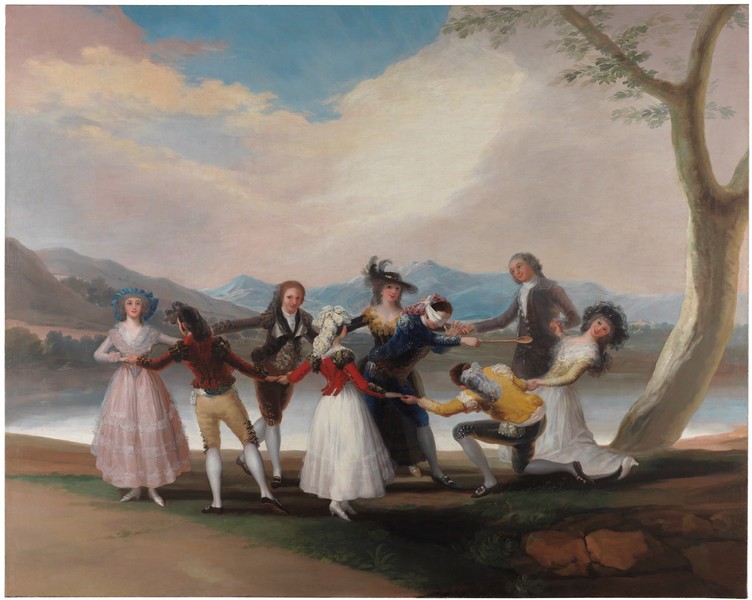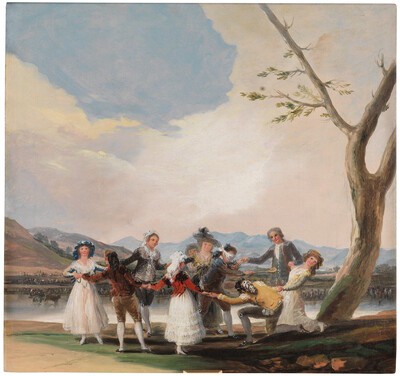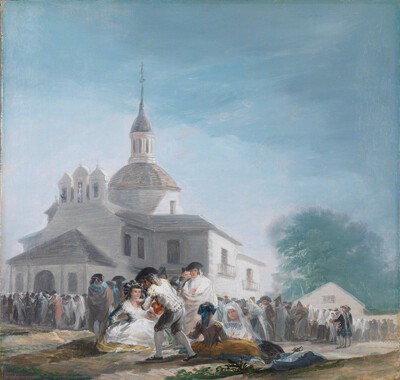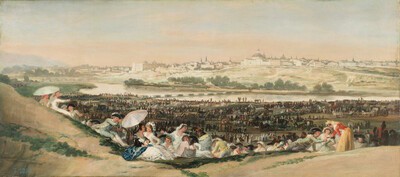- Cronología
- 1788
- Ubicación
- The Prado National Museum. Madrid, Madrid, Spain
- Dimensiones
- 269 x 350 cm
- Técnica y soporte
- Oil on canvas
- Reconocimiento de la autoría de Goya
- Documented work
- Titular
- El Prado National Museum
- Ficha: realización/revisión
- 20 Dec 2009 / 15 May 2023
- Inventario
- P00753
- Otros títulos:
-
The Wooden Spoon Game (El juego del cucharón)
Towards the end of 1787 Goya received the commission to make the cartoons that would serve as models for the tapestries to hang in the Infantas' bedroom. In April 1788 the artist sent an invoice that included five stretchers for the sketches for the series, on which he was still working "with much insistence and displeasure" a month later, which we know from the letter he sent to Martín Zapater on 31 May 1788.
Around 1856 or 1857, this cartoon was moved from the Royal Tapestry Factory to the Royal Palace in Madrid. There it remained in the tapestry basements until it was taken to the Prado Museum, into which collection it entered under orders given on 18 January and 9 February 1870.
In this country scene we see eight people holding hands to form a circle around a ninth figure in the centre that is wearing a blindfold and is holding a wooden spoon. This detail led the cartoon to receive the title The Wooden Spoon Game earlier on. It was Cruzada Villaamil who later called it Blind Man's Buff, or, literally, The Blind Hen.
This is the only cartoon from the series which was to adorn the Infantas' bedroom that was ever actually painted. The oil sketch of the work, in which several differences can be seen, has also been conserved. Goya simplified the composition in the cartoon in order to facilitate its translation into tapestry. As such, the crowd that appears in the background in the sketch has disappeared in the finished cartoon. He also gave greater dynamism to the group of figures, who take on a more credible rhythm than in the sketch, and changed the perspective. In the sketch the dimensions are squarer and the sky is given a more important role, whereas in the cartoon the dimensions are flattened, concentrating more on the group of figures.
Writers have also seen references to love in this painting. Tomlinson understands the work to be a metaphor for blind love, referring to the blindfold worn by the person trapped by his companions.
The similarities with the cartoon Dance on the Banks of the Manzanares are obvious, and this relationship is more than justified since both scenes appear to be set in the same place and both depict activities of leisure and amusement.
-
Goya. 250 AniversarioMuseo Nacional del PradoMadrid1996consultant editor Juan J. Luna. From March 29th to June 2nd 1996cat. 50
-
Goya. La imagen de la mujerMuseo Nacional del PradoMadrid2001from October 30th 2001 to February 10th 2002. Exhibitied also at the National Gallery of Art, Washington, March 10th to June 2nd 2002, consultant editor Francisco Calvo Serrallercat. 10
-
Goya luces y sombrasCaixaForumBarcelona2012consultant editors José Manuel Matilla and Manuela B. Marqués. From March 16th to June 24th 2012cat. 8
-
Goya en Madrid. Cartones para tapices 1775-1794Museo Nacional del PradoMadrid2014p. 175
-
Zaragoza2017cat. 46
-
Goya: Order and disorderMuseum of Fine ArtsBoston2014cat. 179
-
L'œuvre peint de Goya. 4 volsParís1928-1950vol. I, p. 103, cat. 44
-
Tapices de GoyaMadridPatrimonio Nacional1946pp. 156-157, 268, cat. 55 y láms. 172-17
-
Vie et ouvre de Francisco de GoyaParísOffice du livre1970pp. 79, 98, cat. 276 y p. 69 (il.)
-
L’opera pittorica completa di GoyaMilanRizzoli1974p. 103, cat. 235
-
Francisco de Goya, 4 vols.ZaragozaCaja de Ahorros de Zaragoza, Aragón y Rioja1980-1982vol. II, p. 59 y p. 80 (il.)
-
Francisco de Goya y la Corte de MadridReales Sitios1980p. 125
-
Imagen de GoyaMadridLumen1983pp. 78-79, 86-87, 90
-
Francisco de Goya, cartones y tapicescol. col. "Espasa Arte"Espasa Calpe1987pp. 156-157, 307, cat. 60C y p. 156 (il.
-
Francisco de Goya. Los cartones para tapices y los comienzos de su carrera en la corte de Madridcol. col. "Ensayos de Arte Cátedra"MadridCátedra1987pp. 235 y p. 236 (il.)
-
Goya. 250 AniversarioMadridMuseo del Prado1996p. 330, cat. 50 y pp. 132, 133 (ils.)
-
Salas del Palacio Real de El Pardo para las que se tejieron tapices sobre cartones de Francisco de Goya: identificación de las habitaciones y ajuste de las obras de Goya en los alzados de las paredesin HERRERO CARRETERO, Concha (curator, Tapices y cartones de Goya (catalogue of the exhibition organizated at the Palacio Real de Madrid, from may to june 1996)MadridPatrimonio Nacional, Goya 96, Lunwerg1996p. 172 (il.)
-
Cartas a Martín ZapaterMadridIstmo2003p. 275, nº 105
-
Goya en Madrid. Cartones para tapices 1775-1794MadridMuseo Nacional del Prado2014p. 175
-
Goya: Order & DisorderBostonMuseum of Fine Arts Boston Publications2014p. 270




